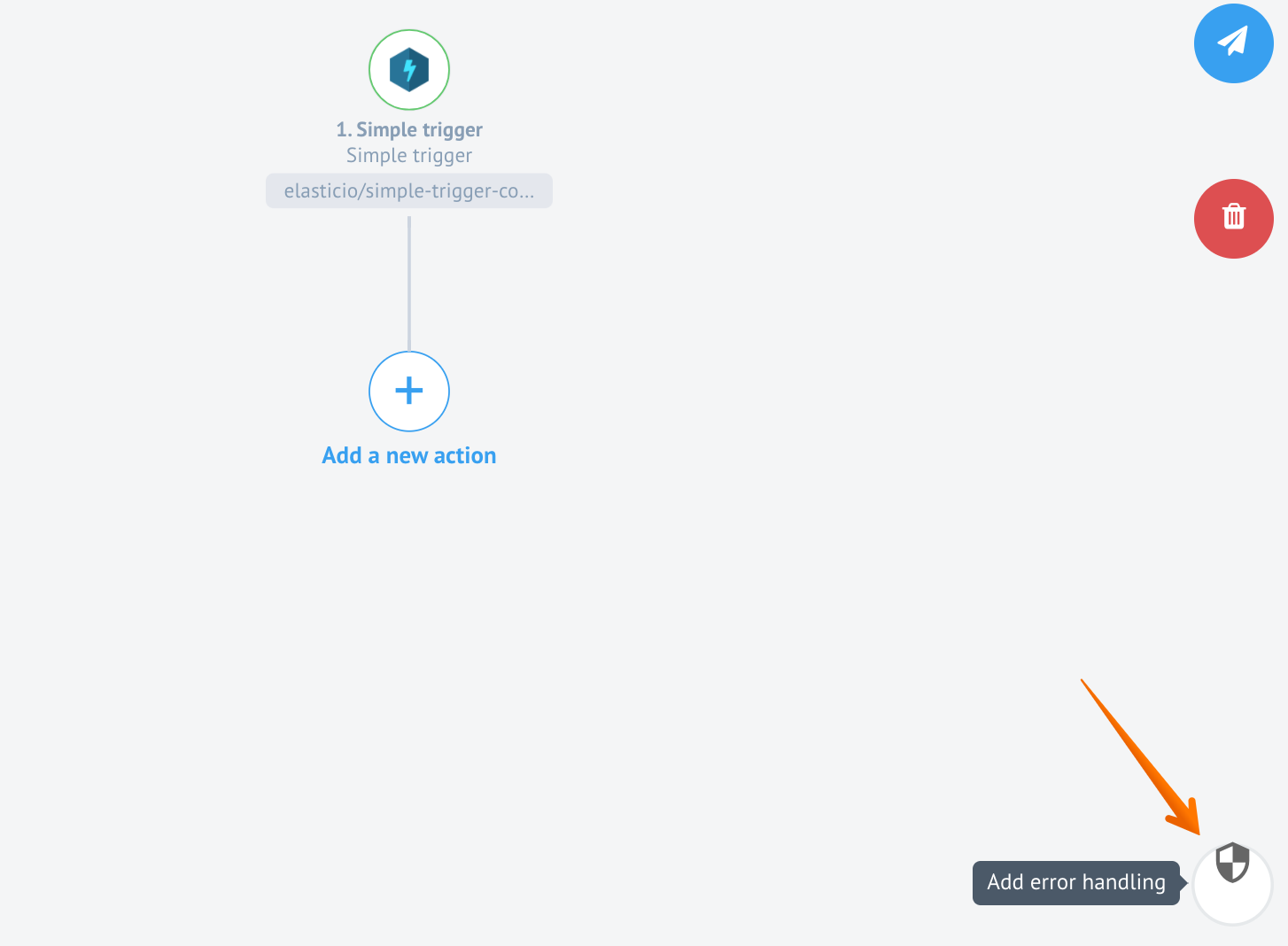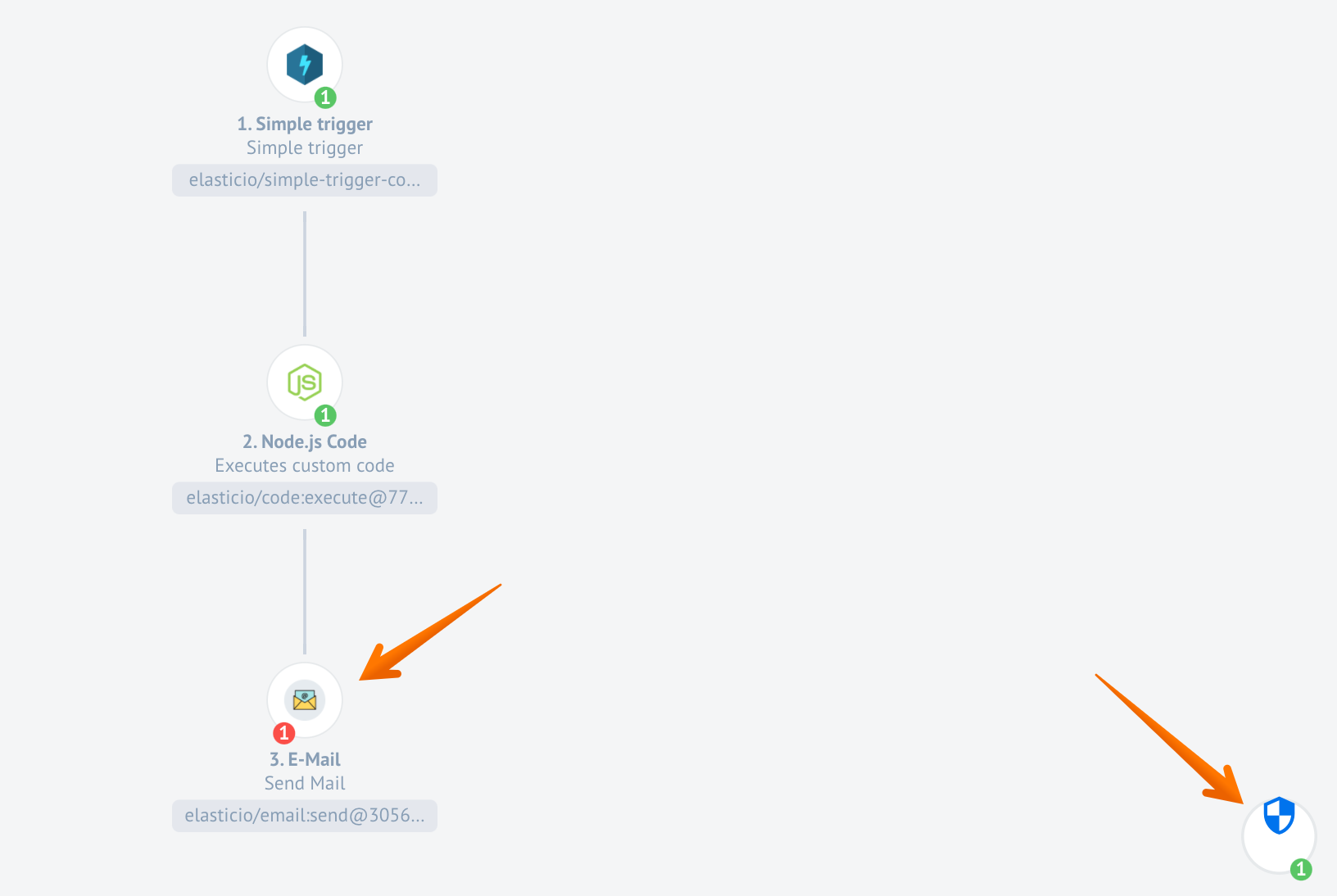Product Update - v20.27
Features
Custom error handling in flows
Please Note, this feature is only available when the new mapper component with Sailor
2.6.13version is installed in the system.
We introduce a new concept for error handling in the integration flows. Now you have a possibility to choose what to do with errors. In short you can handle those errors by building a workflow to catch them and store them in a most convenient way for you.
Before you would get error reports when you subscribe to receive them per email or if you would constantly checking your flows for errors on the platform UI by logging in.
Now you can do both of these if you still prefer it, but you can proactively handle those errors and decide what should happen with these errors and who should handle them.
To use and customise error handling choose the icon presented in the right bottom of the flow designer page after you configure the first step in the flow.

You can choose to configure it right away or wait when you finish the flow design and configure it to handle errors in one go since only one error handling is supported in this version.
Here is how the completed flow with error handling would look. Note, it handled the error in the third step.

In this example all errors in email components get redirected into a separate Google spreadsheet document.
Preconditions
In case when your custom component is not using a system-wide mapper component
right before to map the fields, then it will not show in the component chooser
as a method to process your errors. You can overcome this by upgrading your custom component Node.js Sailor to at least 2.6.13 version.
At this moment the components which do not require mapper component input to function would not show in the components list to choose.
Limitations
At the moment the Custom Error Handling works for limited use cases and errors. For example it can not handle the following cases:
- “Container failed to start” by request-reply as error handler. It causes request timeout on webhook.
- “Container failed to start” original error messages.
The incoming metadata from the Custom Error Handling is hard-coded. It has the following structure:
{
"error": {
"message": "Error message",
"name": "Error name",
"stack": "Error stack trace"
},
"errorInput": {
"properties": {
"headers": { "header":"value" }
},
"content": {
"headers": { "header":"value" },
"body": {}
}
}
}
Improvements
Secrets Management Service Improvements
We continue our improvements and developments of the New Secrets Management service. In this round we made great improvements on authentication parameters.
auth_uri and token_uri for OAuth2
Authentication clients for OAuth2 now support auth_uri and token_uri attributes
in credentials.
Please Note: API-requests for auth-clients is different now. More iformation in auth-clients-(experimental) section of API documentation.
Handling token expiration
Secrets Management Service refreshes tokens 60 second earlier than
exires_in parameter record to ensure the stability of the connection.
expires_in taken from token_expires_in
Now when you create a new secret linked to auth-client with a parameter token_expires_in,
the parameter expires_in gets the value from the token_expires_in data.
Request-reply Response Code
From 1.1.0 version of Request-Reply component you
can add and configure the HTTP response code using the new Response Code
input field during the design phase. Response code is passed in the reply message
header. The default value is 200 by default.
Fixed Bugs
- Fixes the problem when newly created credentials would disappear and appear after UI refresh.
- Addresses the problem with mapper UI when objects in arrays were impossible to modify.
- Addresses the empty title problem in pub/sub topic schema generation.
- Fixes several internal issues connected with the logs delivery delays to UI.
Components
Code component
- UPDATED - Node.js Sailor was updated to
2.6.13.
Mapper component
- UPDATED - Node.js Sailor was updated to
2.6.13.
Router component
- UPDATED - Node.js Sailor was updated to
2.6.13. - FIXED - Problems with flow control.
MongoDB Component
- UPDATED - component updated to use Node v14 and the dependencies are updated accordingly.
- UPDATED - Node.js Sailor was updated to
2.6.10. - IMPROVED - add Emit Batch Behavior to Lookup Plural action
- IMPROVED - add Emit Behavior to Aggregate and Lookup Plural actions
- IMPROVED - input field positions corrected using an order rather than a weight factor.
Microsoft Dynamics CRM component
- NEW - introducing new action Query.
- NEW - introducing new action Delete Object By ID.
- NEW - introducing new action Bulk Create.
- NEW - introducing new action Bulk Update.
- NEW - introducing new action Bulk Delete.
- NEW - introducing new action Lookup Objects.
- IMPROVED - new implementation Upsert action with image attachment support
- IMPROVED - new implementation Lookup Object action with image attachment support
Marketo component
- FIXED - the bug when query string exceeds 8K characters
- UPDATED - component updated to use Node v14 and the dependencies are updated accordingly.
- UPDATED - component logo was updated
- IMPROVED - More clearly report HTTP level failures
SFTP Component
- NEW - introducing new action Move File.
- IMPROVED - component performs better when trying to download large number of files.
Google Spreadsheets
- NEW - introducing support for OAuth clients. Changed the environment variable naming accordingly.
- UPDATED - Node.js Sailor was updated to
2.6.9. - UPDATED - metadata for add new row action.
Magento2 Component
- NEW - introducing new trigger Bulk Extract.
- NEW - introducing new action Lookup Objects.
- NEW - introducing new action Lookup Set of Objects.
- IMPROVED - component now uses the new logger.
- IMPROVED - replaces parameters in error messages when parameters are an object, not an array.
Amazon AWS S3 Component
- NEW - introducing new action Upsert File.
- UPDATED - component updated to use Node v14 and the dependencies are updated accordingly.
- IMPROVED - verify Credentials now checks for access to buckets.
SOAP Component
- IMPROVED - input field positions corrected using an order rather than a weight factor.